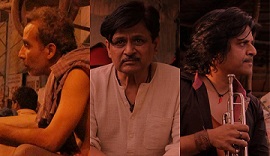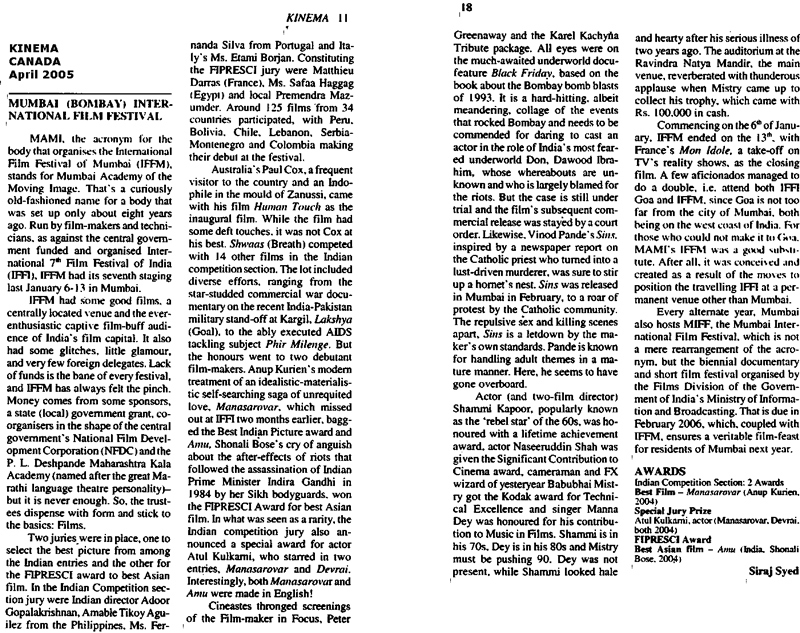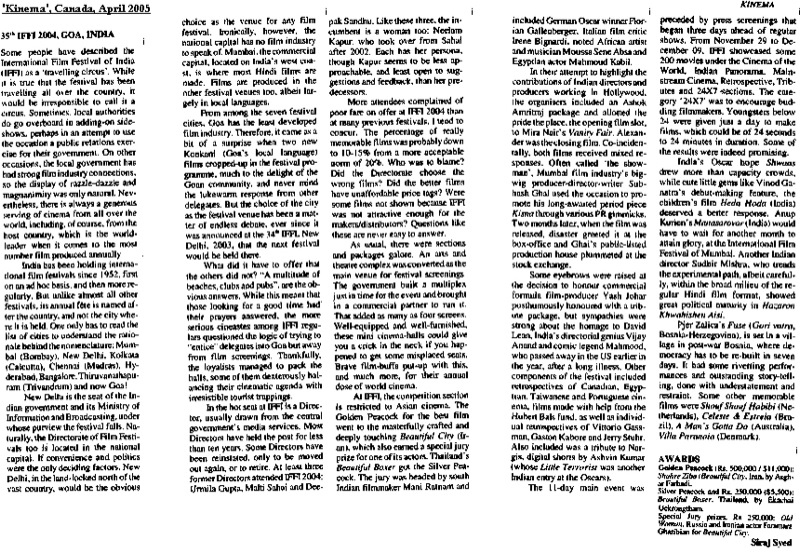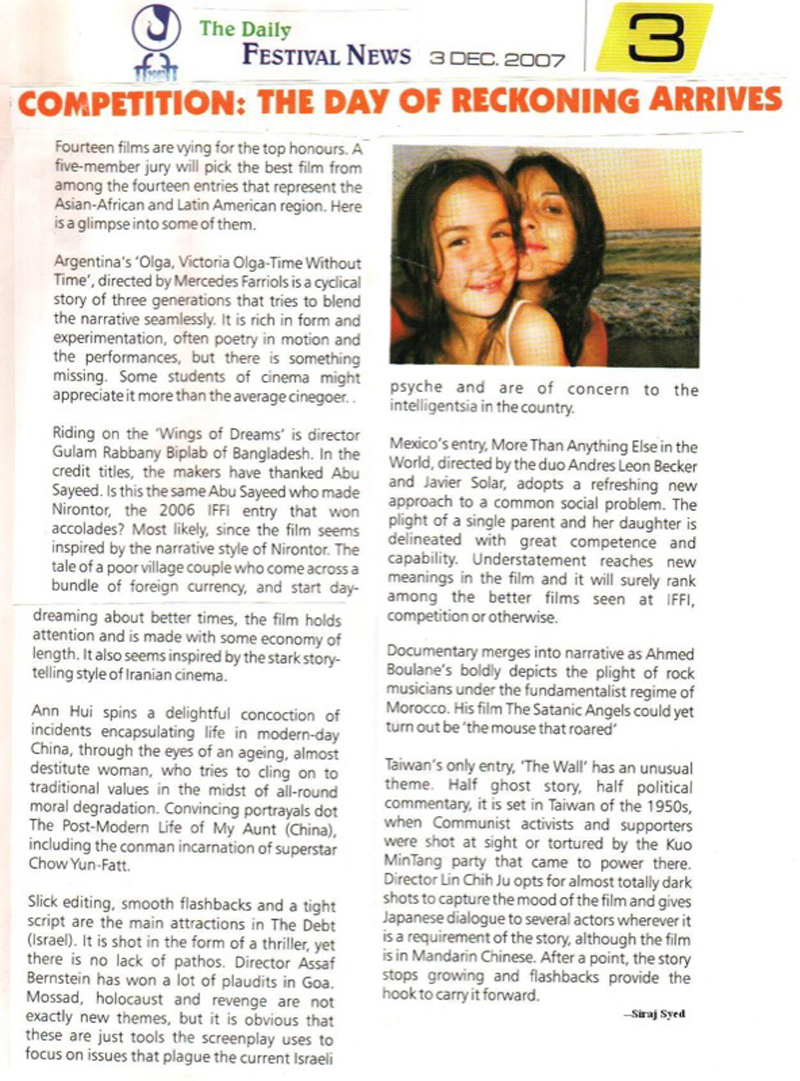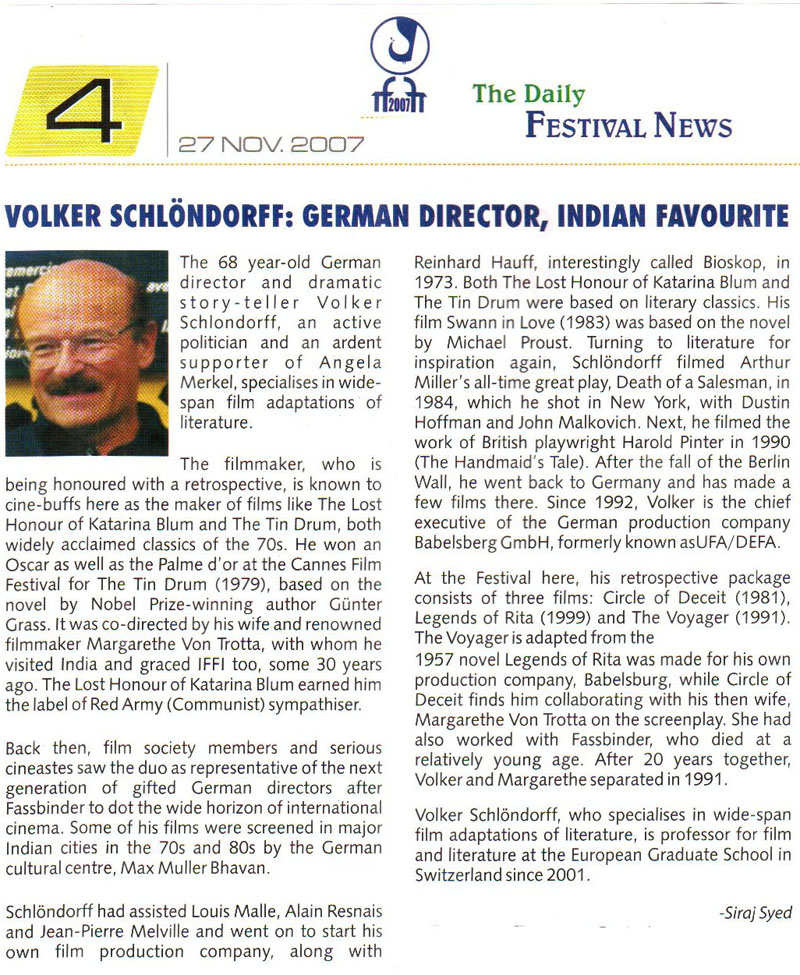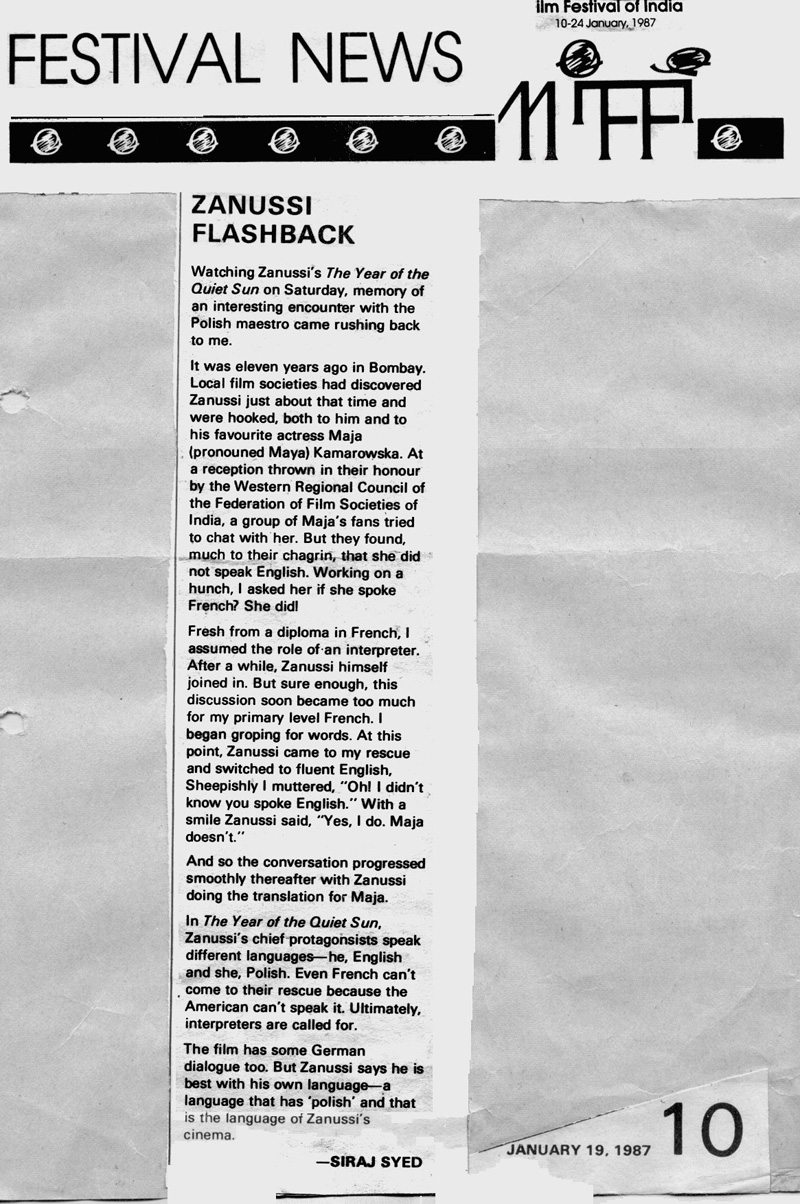|
|
||
|
Pro Tools
FILMFESTIVALS | 24/7 world wide coverageWelcome ! Enjoy the best of both worlds: Film & Festival News, exploring the best of the film festivals community. Launched in 1995, relentlessly connecting films to festivals, documenting and promoting festivals worldwide. Working on an upgrade soon. For collaboration, editorial contributions, or publicity, please send us an email here. User login |
Ghode Ko Jalebi Khilane Le Ja Riya Hoon, Review: Escapist dreamscapes
Ghode Ko Jalebi Khilane Le Ja Riya Hoon, Review: Escapist dreamscapes When translated, the title becomes Taking the Horse to Eat Jalebis, jalebi being an Indian sweet preparation. This is one of the longest film titles in recent times, in the tradition of yesteryear movies like Dr. Strangelove or: How I Learned to Stop Worrying and Love the Bomb (1964) and Oh Dad, Poor Dad, Mamma's Hung You in the Closet and I'm Feelin' So Sad (1967). Ghode Ko Jalebi Khilane Le Ja Riya Hoon (GKJKLJRH) is a curious, even hilarious title, to put it mildly. Firstly, nobody is likely to have heard such a sentence being spoken by anybody, and secondly, horses are not known to eat jalebis, as dessert or main course. So where did this rarest of rare titles come from? According to the screenplay writer-director, Anamika Haksar (now pushing 60), her aunt was waiting to hail a tonga to go for her music tuitions, in the good old days when horse-carts were the only means of transport available in Old Delhi (Dilli, in Urdu). As one cart approached, she called out to the puller, who, without stopping, uttered the words, “Ghode Ko Jalebi Khilane Le Ja Riya Hoon”, and rode past. Riya is a dialectical variation of raha, which would be correct Urdu. The line stayed with her for decades. As a film too, GKJKLJRH is an unconventional, skewed and tangential look at the underbelly of Old Delhi, not in the time of Anamika’s aunt, but in the 2010s. It is from this critical mass that Haksar has picked her characters, and taken seven years to complete the film. She was 52 when it was launched and turned 59 when it was completed. Can’t recall many directors who made their first film at 59! Narrowing down on her choices, Haksar points her camera towards beggars, pickpockets, street-singers, wedding bands, hawkers, rickshaw-pullers, labour leaders, handcart-pullers, heritage walk conductors, road-workers and few others, to assemble a format denying, narrative defying collage that can stand its own against the carefully constructed Slumdog Millionaire. GKJKLJRH never leaves the by-lanes of Old Delhi, a ‘city’ that houses 40 commercial markets, 56 commercial streets, 325 havelis (old mansions) and 783 heritage structures. So congested are the roads of Old Delhi that fires have killed dozens before the fire brigade (water-tenders) could reach the spots and many an inhabitant has died en route to the nearest hospital, because the cycle-rickshaw was the only transport that could move through the jams, and it took ages to reach its destination. Surrealistic images, meticulous animation, painting and folk art are the tools that come alive in the hands of the competent debutante, who has done a lot of work in theatre. Sweet dreams and nightmares keep dotting the drudgery and abject poverty that is the lot of the natives. In a new take on ‘community dreaming’, we have dreams overlapping, and a dreamer waking-up because his neighbor, sleeping on the next mattress, came into his dream and ruined it. One particular dream has the labour-leader waving a huge flag across almost the whole screen, while a goddess looks nonplussed. Others have holy cows, snakes, fires and even a version of Mickey Mouse. Absurd? Yes, theatre of the absurd. To hang the images, the Anamika Haksar has four character pegs to frame her picture: a vendor who sells a variety of sweets in turns, a pickpocket-cum-musician-cum-wannabe heritage walk conductor, a regular heritage walk conductor and an aspiring labour leader. A lot of the dialogue (Lokesh Jain) is either off camera or not in sync, with sound heard while lips are still. This must be partly because some 75 people were interviewed over a period of two years, and what we hear are excerpts from those endless recordings. Theatre actor Ravindra Sahu is cast as the pickpocket and band musician, Patru, who takes good care of his old and ailing father, and who tries to upstage the heritage walker. His is the biggest role in the film and he carries it well, exuding a lot of energy. Often, his face reminds us of old-timer actor-comedian Junior Mahmood. Theatre and celluloid veteran Raghubir Yadav, who has adorned the big screen for nearly 35 years now, as the sweet vendor, Chhadami, is a natural in the milieu the film dwells-in, very obviously so. Another theatre actor, K. Gopalan, plays the part of the labour-rouser, LalBihari, but his performance suffers by comparison. Lokesh Jain, a social activist and the film’s dialogue-writer, is named Akash Jain, and cast as the heritage walk conductor, who spouts flowery Urdu, once the state language in many parts of India, and walks through the role, till his job is nearly high-jacked by Patru. Considering the free-wheeling treatment, one can rightfully ask, why did Anamika not dig out these quadrangular four from her mass of non-actors, instead of settling for trained talent? Might have been a tough act to pull off, but would have added great value to the content. Jain is a known Urdu-Persian aficionado, and by incorporating segments that pay tribute to the rich poetic heritage of Old Delhi, and to Delhi-based poets of the impeccable stature of Mirza Asadullah Khan ‘Ghalib’, ‘Daagh’ and ‘Meer’, he has done yeoman’s service to Urdu, arguably India’s sweetest and most poetic linguistic wealth, but a victim of neglect and discrimination over the last 70 years. With such credentials, Jain should not have been making pronouncing errors himself, and neither should he have allowed other actors that luxury. As it is, most TV serials and films made during the last twenty years revel in mis-pronouncing words that are of Urdu origin but are an integral part of what is loosely dubbed Hindustani (Urdu+Hindi). One might also wonder how is it that on more than one occasion in the film, obviously Caucasian looking tourists, when addressed in chaste Urdu by Jain, understand what is being said, and react accordingly. Although the language of the film is specified as Hindi on the certificate issued by the Central Board of Film Certification, it thrives on dialects that range from those that are close to Hindi, to others that may not be intelligible to Hindi speakers. And then there is honey-dipped Urdu. Constraints of space and the need to respect the dignity of the wretched must have posed serious challenges to the filming, and it is to the credit of Film and Television Institute of India (FTII) alumnus, cinematographer Saumyananda Sahi, that we have fragments that add up to an ill-fitting, awkward jigsaw, but a jigsaw nevertheless. Film editing by another alumnus of the FTII, Paresh Kamdar, who is a screen-writer and director as well, needs to be commended even more, for culling a coherent, cogent progression, an unenviable task, given the heaps of accumulated footage and the absence of a linear narrative. Another department that earns encomiums is the sound design, headed by audiographer Gautam Nair (from the FTII, you guessed it). Only ambient sounds, and no dubbing, makes so many of the visuals come alive and talk to you in their natural tones. By imparting escapist dreamscapes, recreating the actual dreams, churned from 25 of them, to flesh-and-blood figures, vagrants and migrants, marginalised and herded, the director has designed her own idiom. Expletives, as should be expected, are an inherent part of the vocabulary. When real-lives stare you in the face, who needs similes and metaphors? One metaphor, though self-deprecating, is found in the banner itself: Haksar calls her company Gutterati Productions. Ghode Ko Jalebi Khilane Le Ja Riya Hoon is not a masterpiece, but a piece that can muster recall and re-appraisal in the years to come. Festival exposure and awards would go a long way in giving Haksar her due. Not everyone sells their house and then works for seven years, going around with a piggy bank, to buy into 121 minutes of subaltern culture, not in the 21st century, in a setting where you can get a street-side square meal at the less than rock-bottom price of Rs. 10 ($0.14, at current conversion rate). So many of the denizens of this minimum city sleep high-up, on open terraces, but lead such a lowly life. Experimental indulgences such as GKJKLJRH are not likely to rake-in money, devoid as they are of stars, songs, stereo-type structures and promotional deluges. But the film needs to be seen by students of cinema and movie-buffs who are open to rules being broken and the medium being explored. Waiting for it to reach multiplexes, or even single screen cinema-halls, might turn out be an exercise in futility. So look out for GKJKLJRH at special screenings and on new media platforms. Rating: *** ½ Trailer: https://www.youtube.com/watch?v=M23_03Gk4OA 04.03.2019 | Siraj Syed's blog Cat. : Anamika Haksar Chandni Chowk Gautam Nair K. Gopalan Lokesh Jain Old Delhi Paresh Kamdar Raghubir Yadav Ravindra Sahu Saumyananda Sahi ShahJahanabad Urdu Independent FILM
|
LinksThe Bulletin Board > The Bulletin Board Blog Following News Interview with EFM (Berlin) Director
Interview with IFTA Chairman (AFM)
Interview with Cannes Marche du Film Director
Filmfestivals.com dailies live coverage from > Live from India
Useful links for the indies: > Big files transfer
+ SUBSCRIBE to the weekly Newsletter Deals+ Special offers and discounts from filmfestivals.com Selected fun offers
> Bonus Casino
User imagesAbout Siraj Syed Syed Siraj Syed Siraj (Siraj Associates) Siraj Syed is a film-critic since 1970 and a Former President of the Freelance Film Journalists' Combine of India.He is the India Correspondent of FilmFestivals.com and a member of FIPRESCI, the international Federation of Film Critics, Munich, GermanySiraj Syed has contributed over 1,015 articles on cinema, international film festivals, conventions, exhibitions, etc., most recently, at IFFI (Goa), MIFF (Mumbai), MFF/MAMI (Mumbai) and CommunicAsia (Singapore). He often edits film festival daily bulletins.He is also an actor and a dubbing artiste. Further, he has been teaching media, acting and dubbing at over 30 institutes in India and Singapore, since 1984.View my profile Send me a message The EditorUser contributions |

















